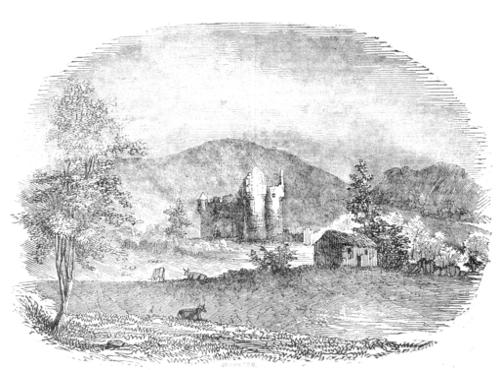THE IRISH PENNY JOURNAL.
| Number 30. | SATURDAY, JANUARY 23, 1841. | Volume I. |

THE CASTLE OF MONEA, COUNTY OF FERMANAGH.
The Castle of Monea or Castletown-Monea—properly Maghan fhiaidh, i.e. the plain of the deer—is situated in the parishof Devinish, county of Fermanagh, and about five miles north-westof Enniskillen. Like the Castle of Tully, in the samecounty, of which we gave a view in a recent number, thiscastle affords a good example of the class of castellated residenceserected on the great plantation of Ulster by the Britishand Scottish undertakers, in obedience to the fourth articleconcerning the English and Scottish undertakers, who “are toplant their portions with English and inland-Scottish tenants,”which was imposed upon them by “the orders and conditions tobe observed by the undertakers upon the distribution and plantationof the escheated lands in Ulster,” in 1608. By this articleit was provided that “every undertaker of the greatestproportion of two thousand acres shall, within two years afterthe date of his letters patent, build thereupon a castle, with astrong court or bawn about it; and every undertaker of thesecond or middle proportion of fifteen hundred acres shallwithin the same time build a stone or brick house thereupon,with a strong court or bawn about it. And every undertakerof the least proportion of one thousand acres shall within thesame time make thereupon a strong court or bawn at least;and all the said undertakers shall cause their tenants to buildhouses for themselves and their families, near the principalcastle, house, or bawn, for their mutual defence orstrength,” &c.
Such was the origin of most of the castles and villages nowexisting in the six escheated counties of Ulster—historicalmemorials of a vast political movement—and among the restthis of Monea, which was the castle of the middle proportionof Dirrinefogher, of which Sir Robert Hamilton was thefirst patentee.
From Pynnar’s Survey of Ulster, made in 1618-19, it appearsthat this proportion had at that time passed into thepossession of Malcolm Hamilton (who was afterwards archbishopof Cashel), by whom the castle was erected, thoughthe bawn, as prescribed by the conditions, was not added tillsome years later. He says,
“Upon this proportion there is a strong castle of lime andstone, being fifty-four feet long and twenty feet broad, buthath no bawn unto it, nor any other defence for the succouringor relieving of his tenants.”
From an inquisition taken at Monea in 1630, we find, however,that this want was soon after supplied, and that thecastle, which was fifty feet in height, was surrounded by a wallnine feet in height and three hundred in circuit.
The Malcolm Hamilton noticed by Pynnar as possessor of“the middle proportion of Dirrinefogher,” subsequently heldthe rectory of Devenish, which he retained in commendam withhis archbishopric till his death in 1629. The proportion of Dirrinefogher,however, with its castle, was escheated to the crownin 1630; and shortly after, the old chapel of Monea was convertedinto a parish church, the original church being inconvenientlysituated on an island of Lough Erne.
Monea Castle served as a chief place of refuge to theEnglish and Scottish settlers of the vicinity during the rebellionof 1641, an